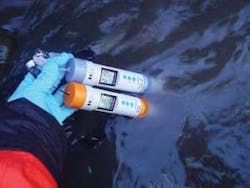Metering Products Now on Every Continent on Earth
By Rob Samborn
Reliable water testing instruments from HM Digital were chosen for a Spanish expedition to measure pollution in Antarctic waters.
The water was near freezing off the Antarctic Peninsula as a team of researchers arrived, but HM Digital’s water testing instruments dutifully provided the scientists with the required data.
After months of preparation, the Environmental, Biochemical and Nutritional Analytical-Control Research Group of Spain’s University of Granada finally reached Antarctica for its expedition to analyze pollution in Antarctic waters in late-January.
The expedition – financed by the Spanish Ministry of Education – ran from Jan. 15 to Feb. 19, but really began Nov. 5 when research material arrived for loading aboard the Las Palmas vessel at port in Cartagena, Spain. From here the research team departed four days later for Ushuaia, Argentina, before heading for the Antarctic on Jan. 18. Stopping at Deception Island and other spots along the way, they spent Jan. 28-31 actually on the peninsula.
The project’s aim was to collect and analyze water samples, for 33 parameters set by the European Union. Many of these parameters were to be tested once the samples returned to Europe. For on-site testing, the expedition chose HM Digital’s COM-100 and PH-200 handheld water meters.
Both are waterproof and durable, with long-lasting batteries, quick response times and large, easy-to-read screens, all of which are necessary in a place that experiences the worst weather on the planet.
The COM-100 tests conductivity, temperature and TDS levels of samples, and the PH-200 tests pH levels. And with their highly advanced automatic temperature compensation (ATC) programs, the meters will be able to handle the extreme temperatures of the Antarctic waters.
“In such chilly conditions, it was important for us to find the right instruments that would be reliable and accurate,” said Dr. Jorge Fernando Fernández Sánchez, one of the leaders of the expedition. “The HM Digital sensors have worked very well, even in the near-freezing waters. Analyzing the Antarctic waters is an important venture that will hopefully lead to solutions for global warming and world pollution.”
“We couldn’t be happier that HM Digital’s instruments were chosen for this expedition,” said Charles Lee, the company’s managing director. “We have sold tens of thousands of meters on every other continent, but I never thought they’d go to Antarctica. It’s truly quite an accomplishment. Knowing that our instruments may help provide answers to one of the greatest challenges of our times is an honor.”
The team of scientists on the expedition visited five locations on Antarctica and nearby islands for collecting and testing water samples. The expedition and its results – including photos and a detailed log of the trip – can be viewed in English and Spanish at www.ugr.es/~fqm297/index-ant.htm WWi
Author’s Note:
Rob Samborn is sales & marketing director at HM Digital Inc., a water testing instrumentation specialist formerly known as Heemang Manufacturing. Based in Culver City, California, USA, it was established in 1987. Contact: 310-410-3100 or www.tdsmeter.com
null


